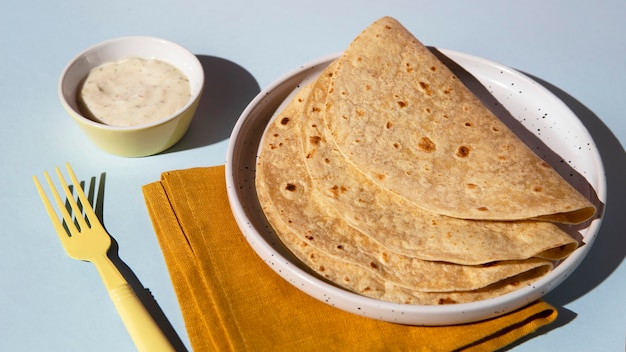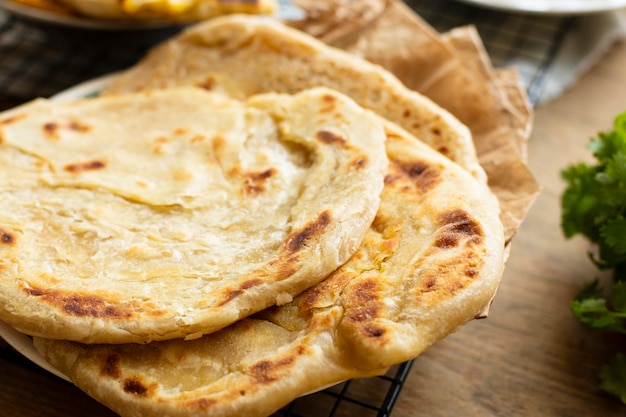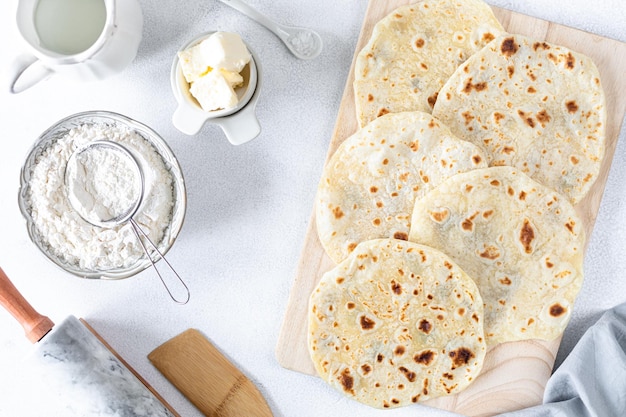Part 1: My Naan Bread Journey: From First Bite to Home-Baked Bliss

My naan journey started with a trip to India a few years back. The sheer variety of food completely floored me, but it was the naan bread that truly stole my heart. I remember sitting in a bustling street food stall, watching the dough being expertly tossed and cooked in a tandoor oven. It was a culinary revelation, and I knew I had to learn how to make it myself.
Part 2: The First Attempt (and a Few Mistakes): A Journey of Culinary Discovery

My first attempt at making naan wasn’t exactly a triumphant success. I followed a recipe I found online, but the dough was way too sticky, and the bread ended up flat and tough. It was a definite learning experience, but it also ignited a determination within me to master this delectable bread.
The Importance of Ingredients: Quality Matters
One of the key things I learned was the importance of using high-quality ingredients. The flour, in particular, makes a huge difference. I've found that using a strong bread flour, like "strong plain flour" in the UK, gives the naan its characteristic chewiness. You'll also want to make sure your yeast is fresh, and don't forget the ghee! This clarified butter adds a rich, buttery flavour and helps make the naan wonderfully soft.
The Power of Kneading: A Gentle Art
Another crucial factor is kneading the dough. You need to knead it thoroughly, as this develops the gluten and gives the naan its texture. Don’t be scared to get your hands dirty! It’s part of the fun (and you can wash them later, of course).
Part 3: The Recipe: Easy Homemade Naan

Alright, let's get to the recipe! This is the one I've perfected over the years, and it's so simple that even a novice baker can make delicious naan.
Ingredients:
- 300g strong plain flour
- 1 tsp dried yeast
- 1 tsp sugar
- 1 tsp salt
- 175ml warm water
- 2 tbsp ghee, melted
- 1 tbsp plain yoghurt (optional, but highly recommended)
Instructions:
- In a large bowl, mix together the flour, yeast, sugar, and salt.
- Gradually add the warm water, mixing with a spoon until a dough forms. Be careful not to add too much water, as this can make the dough too sticky.
- Turn the dough out onto a lightly floured surface and knead for 5-7 minutes, or until smooth and elastic. You should feel the dough become more pliable and less sticky as you knead it.
- Place the dough in a lightly oiled bowl, cover with cling film, and leave to rise in a warm place for 1 hour, or until doubled in size. This is where patience comes in! A warm oven with the light on can be a good place to let it rise.
- Once the dough has risen, punch it down and divide it into 8 equal balls. The dough should have a nice airy texture now.
- On a lightly floured surface, roll each ball of dough into an oval shape, about 15cm long and 10cm wide. This is where you can use a rolling pin or simply use your hands to gently flatten the dough. Don't worry if they're not perfectly oval.
- Heat a large frying pan or griddle over a medium heat. The pan should be hot enough to sizzle slightly when you add a drop of water to it.
- Brush one side of each naan with melted ghee. This will give the naan a lovely golden color and a delicious buttery flavour.
- Cook the naan for 1-2 minutes per side, or until golden brown and slightly puffed up. You'll see the naan start to puff up as it cooks.
- Serve immediately. The naan is best enjoyed fresh and warm.
Part 4: Tips and Tricks for Perfect Naan: Elevate Your Baking Game
Here are a few tips and tricks to make your naan even better:
Use a Tandoor Oven (if you have one!)
Traditionally, naan is cooked in a tandoor oven. This clay oven creates a unique smoky flavour and gives the naan that slightly charred edge. If you happen to have a tandoor oven at home, feel free to use it and experience the authentic flavour!
The Secret to a Fluffy Naan: A Light and Airy Touch
For a super fluffy naan, try adding a tablespoon of plain yoghurt to the dough. It adds moisture and helps to create a light and airy texture. This is especially helpful if you're using a pan rather than a tandoor.
Experiment with Flavours: Beyond the Basics
Don't be afraid to experiment with different flavours! You can add herbs like coriander, mint, or garlic to the dough, or brush them on before cooking. You can also try adding a pinch of chilli powder for a spicy kick. Let your creativity run wild!
The Art of Tandoori Cooking: A Hot and Fiery Technique
If you're feeling adventurous, you can try cooking the naan in a cast iron skillet. Heat the skillet over a high heat and then place the naan directly onto the surface. This method can give the naan a slightly crispy texture and a bit of char. Be careful, as cast iron skillets get very hot!
Part 5: Serving Suggestions: Unleash Your Naan Creativity
Naan is so versatile, it's hard to pick just a few serving suggestions. Here are some of my favourites:
The Classic Pairing: Curry and Naan - A Match Made in Heaven
Of course, the classic pairing is curry and naan. It's a truly irresistible combination. You can't go wrong with a good chicken tikka masala, a creamy saag paneer, or a fiery vindaloo. Just be sure to have plenty of naan on hand to soak up all that delicious sauce!
Naan as a Wrap: A Deliciously Versatile Option
Naan is also perfect for making wraps. You can fill it with anything you like, from grilled chicken and vegetables to hummus and falafel. The soft texture of naan makes it perfect for holding together all sorts of fillings.
Naan as a side dish: A Flavourful Addition
Naan can also be served as a side dish, alongside grilled meats or roasted vegetables. It's a great way to add a touch of flavour and texture to your meal, complementing both savoury and sweet dishes.
Part 6: The Importance of Naan: More Than Just Bread
Naan is more than just a bread. It’s a symbol of Indian culture and hospitality. It’s something that brings people together, whether it’s around a family dinner table or at a bustling street food stall.
The Social Side of Naan: A Culinary Connection
I've found that sharing naan with friends and family is a really special experience. You tear off pieces of the warm, soft bread and share them with everyone, enjoying the delicious flavour and the company. It's a simple act that creates a sense of connection and togetherness.
Naan Beyond Borders: A Global Culinary Delight
Naan is not just popular in India. It’s now enjoyed all over the world, and it’s a testament to the power of food to bring people together. I’ve met people from all walks of life who have a deep love for naan, and it’s a reminder that food is truly universal.
Part 7: My Naan Memories: A culinary journey of Delight
I’ve got so many fond memories of naan. I remember the time I made a huge batch for a potluck dinner, and it was the first thing to disappear. I remember sharing a plate of naan with friends at a local Indian restaurant, laughing and talking late into the night.
And I remember the first time I successfully made naan at home, how proud I felt of myself. It was a moment of culinary triumph, and I knew I had mastered a skill that would bring me joy for years to come.
Part 8: More Than Just a Bread: A culinary legacy
Naan is more than just a bread. It’s a story. It’s a tradition. It’s a flavour that evokes memories and brings people together.
I encourage you to try making naan at home. You might be surprised by how easy it is, and you might even find yourself creating your own naan memories.
FAQs: Common Naan Questions Answered
| Question | Answer |
|---|---|
| Can I use regular flour instead of strong plain flour? | Yes, you can, but you might find that the naan is a little bit tougher. Strong plain flour contains more gluten, which helps to give the naan its characteristic chewiness. If you're using regular flour, you might want to increase the kneading time to help develop the gluten. |
| What happens if I don't have ghee? | You can use unsalted butter or even olive oil instead of ghee. However, ghee does add a unique flavour that you might miss. Ghee is clarified butter that has been simmered until the milk solids have been removed, resulting in a rich and buttery flavour. |
| Can I make the dough ahead of time? | Yes, you can make the dough a day ahead and store it in the refrigerator. Just bring it to room temperature before rolling it out and cooking it. The dough will have a chance to fully rise in the fridge, giving you even more flavour and texture. |
| What if my naan doesn't puff up? | Make sure the pan is hot enough before you add the naan. If the pan isn't hot enough, the naan won't puff up properly. Also, make sure you don't overcrowd the pan. Give the naan enough space to cook and puff up. If you're using a pan, a bit of steam can also help the naan puff up. You can add a few drops of water to the pan before adding the naan. |
| What are some other ways to cook naan? | You can cook naan in a tandoor oven, a cast iron skillet, or even a regular oven. If you're using a regular oven, preheat it to 200°C (400°F) and bake the naan for 5-7 minutes, or until golden brown. If you're using a tandoor, the naan will cook very quickly, so be sure to keep a close eye on it. |
Everyone is watching

Corn on the Cob: The Ultimate Guide to Perfectly Cooked Ears
Healthy MealsAh, corn on the cob. Just the name evokes images of sunny days, barbecues, and that sweet, juicy flavour that ...

Perfect Pork Roast Oven Cooking Time: A Guide to Delicious Results
Healthy MealsThere's something truly satisfying about a perfectly roasted pork. The aroma alone is enough to make your mout...

Ham Cooking Time: How Long to Bake, Smoke, or Boil a Delicious Ham
Healthy MealsAh, ham. It's a classic, isn't it? A real crowd-pleaser, especially around holidays. And when done right, it'...

Scallops: The Ultimate Guide to Perfect Cooking
Healthy MealsAh, scallops. Those delicate, sweet, and utterly delicious morsels of the sea. They hold a special place in my...

Spaghetti Squash: The Ultimate Guide to Cooking and Serving
Healthy MealsRemember that time you saw spaghetti squash at the supermarket, looking all bumpy and strange, and thought, "W...
